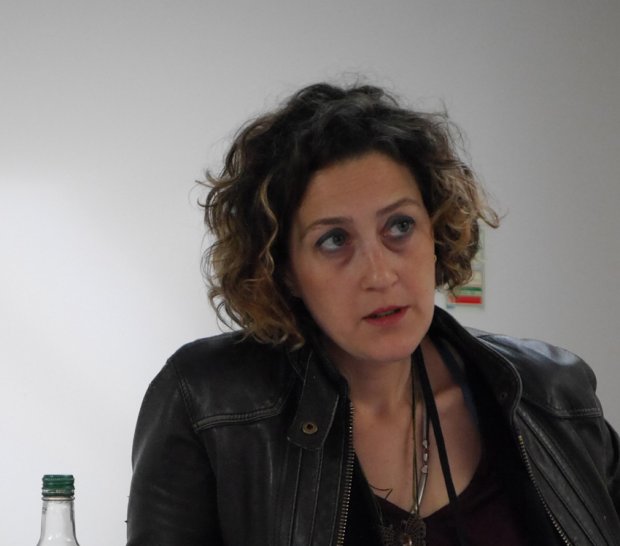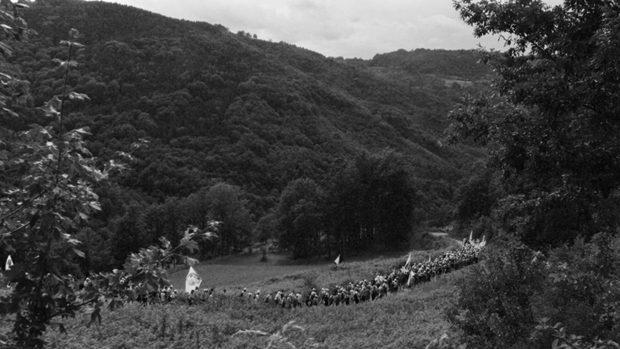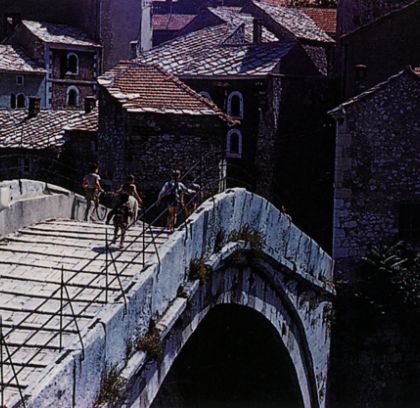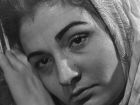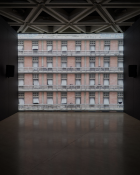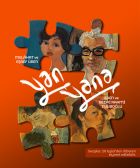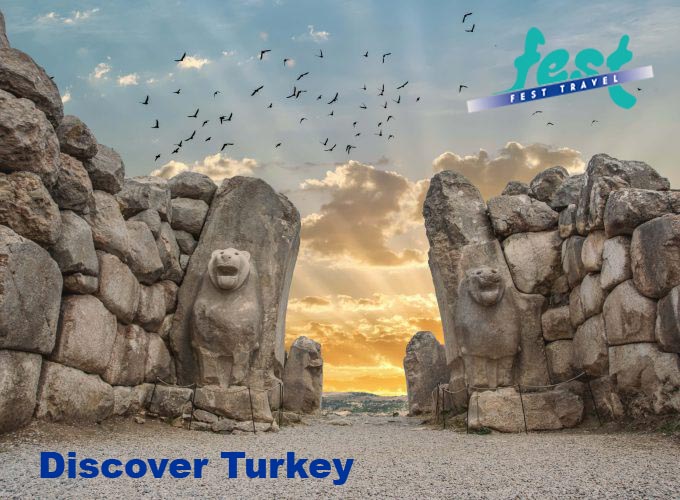Two art film directors from Turkey were represented at this year’s Alchemy Film and Moving Image Festival in the Scottish Borders: Didem Pekün, with Araf (UK premiere), and Nazlı Dinçel, with Shape of a Surface.
Araf follows the diary of a ghostly character, Nayia, who returns to Bosnia for the 22nd memorial of the Srebrenica genocide. Woven through the film is the ancient myth of Daedalus and Icarus – Icarus also being the name given to the winner of a bridge diving competition in Mostar, in her home country.
Shape of a Surface explores the ruins of the city built for Aphrodite. As she takes revenge on Narcissus, mirrors reveal surfaces, limbs dismantle, and marble turns to flesh. Nazlı Dinçel's short 16mm film was presented as part of this year's Ann Arbor Film Festival's touring programme.
We invited local filmmaker Narda Azaria Dalgleish to talk to Araf's director, Didem Pekün.
NAD: Some methods of dream analysis propose that all the players and elements in a dream represent different aspects of oneself. Would it be fair to suggest that your film may also stand as a metaphorical mirror, which reflects back to us our real state of affairs today? That we are like that ancient lunar clock tower which needs to be calibrated every three days but is still permanently out of touch.
DP: The dream notion is intriguing, because I was in a trance when I was making this film, or perhaps in a nightmare I was unable to snap out of. Everything fell into place in that manner, in the sense of how the team came together, how the production materialized out of a series of what almost looked like impossibilities.
Regarding your question, of course there are myriad ways to read a film and connect the dots, but yes, I think you are right, and it makes total sense to put the pieces of the film together through this method.
What you say are the lines of thought I was wandering in, that our current predicament is like inhabiting a radical temporariness – that the clock has gone completely out of synch.
There are also many more things that were in our minds when I was discussing the film with Maria-Thalia Carras (the executive producer, who had a very hands-on role in every aspect of the film). This film is also an elegy in slow motion; an elegy of an event that the world fast-forwarded. I wanted to rewind and replay and really look to see through the commemoration, because commemoration is an act of protest against this repulsive phenomenon of genocide and the desire to erase a people from history.
Yet, on another level, if it is a crime against humanity, a crime against all of us – hence we wanted to make a film that shared the pain with the locals of that particular place and event. I thought through each screening that we, the people who gather in front of the screens, would perhaps stand there together and share.
And I could only deal with a question of such immense size through a mythical approach, moving above nation-states, ethnicities and religion to think about them in archetypal senses. That we, each of us, are Daedaluses (our safety measures), but we are each also Icaruses (our wondrous, brave, optimistic and future-holding aspect).
NAD: I think you have achieved in Araf a sense of a soaring, dignified humanity, not only by using slow motion, but also by stripping down the colour and muting the sound, which is especially powerful in the prayer scene at the graveyard. Can you say something about these artistic choices?
DP: The visual choices were discussed with Petros Nousias (the cinematographer) prior to the shoot and it was a mutual decision from the beginning. Black and white was chosen to highlight the timelessness and also open up a possible space for discussion for placelessness. What I mean by timelessness and placelessness is that nowhere in the voice-over text do I say ‘Bosnia, or Srebrenica’. The only geographic- specific word I use, and that I do only once, is Neretva, the river’s name. The choice to never name a geography and/or ethnicity, alongside the black and white photography, is to remove the specificities and really focus on the phenomenon itself, and on something that surpasses all of the specificities and that unites all of the living and the dead.
And this was particularly clear in the prayer – the shared pain in the sheer togetherness. When one strips away everything, from colour to sound, we are left confronting the faces, and once we really look at that pain in the face, we can no longer turn our back, because there is also beauty there, in humanity.
I will never know what they feel, but that should not stop us from attempting to be there and together to commemorate an event that scars the whole of humanity.
NAD: The film’s music enhances the strong yet serenely tender quality of the film very well. Could you say something about this?
DP: There are two musical things happening there, and that too fell into place like the rest of the production. Elena Kakaliagou is a friend I hadn’t seen for a while. When I was in the pre-production stage of the film we met, and she gave me some of the projects she was working for on. She is a French-horn player and plays in different bands as well as having her own project with Ingrid Schmoliner.
When I heard Elena’s sound, I fell for it. The pieces she composed with Ingrid (who plays prepared piano and composes) are also all mountain songs, all to do with women and nature. There is a short poem in their album, Nabelóse, from which I took three pieces for the film, it reads:
A song cycle
Reflecting departures
From home, love, livelihood, body
Leaving behind one’s abode
Traces remain
Moving through sea and river
Imprints in water.
It is quite striking how the themes we were working on were similar. On the other hand, the main repeating theme of the film over the Icarus scenes is Ellen Arkbro’s incredible minimalist composition Mountain of Air. Again, when I was editing that sequence, I put the tune on and never removed it. It was as if Ellen had composed the piece for the film.
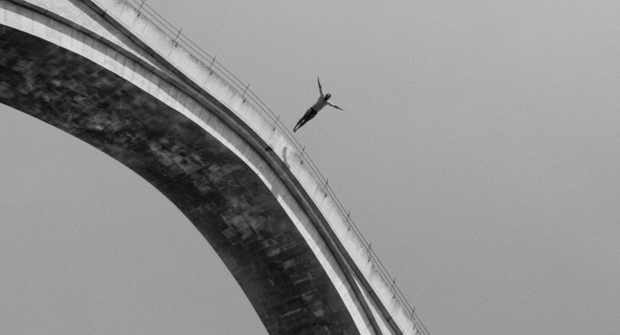
NAD: “Who was overambitious and fell into the mercy of the river? Ask the river.” I was moved by this striking question. Could you say something about this?
DP: It is such a key sentence you pick up on: It was one of the first things I wrote, when the film was a two-page proposal. One thing was key and that was the role of nature.
What I mean by that is that I wanted to weave throughout the film a certain perseverance through the idea of the Amazonian animist line of thought – to re-assert that evil can never downplay life. Life will persist in insuppressible ways, whether as memories carried in the river to be rebuilt, whether as humans progressing to becoming animals and stones and so forth – as I narrate later in the film. The river is older than us, the river carries parts of historical humanity, and as the river persists, so will life.
NAD: Do you mean that the mercy of the river is in its persistence?
DP: Sort of, yes. But you know the usual interpretation of Icarus concerns over-ambition and falling into pieces... So, whoever is over-ambitious and falls into the mercy of the river – will they survive, or will they die?
But then, who is the river? I am imbuing the river with life and referring to animist traditions where the river is exalted. In that sense, I am trying to think of the superiority of nature, that nature carries fragments of histories and humanity within it. All of history is alive within the river.
The key here in that particular part is meant to signal this main thread in the film, which is that everything has life — it is most clearly highlighted by the Amazonian Indian myth that is part of the narration: everything starts life as human but then evolves into stones and trees and rivers. And, in that sense, I am thinking of animism as that force which carries ‘life’ against all odds. As I say at the very end of the film:
“But if that myth is true, and I think it is, everything is them.
The stones, the birds, the trees and the waters — they are not gone.”
NAD: You come from a rich culture in Turkey, steeped in a poetic mystical tradition. I wonder to what extent your own culture also informs or inspires your talent to deliver moving-image in metaphors? Also have any contemporary Turkish artists had an influence on your work?
DP: Hard to pinpoint exactly, but I am most certainly very inspired by, for instance, Alevi deyiş, the mystical poetry that is sung and accompanied by the saz. But later, when I studied ethnomusicology, I was very into shamanic traditions and the relationship between humans and nature and the role music had in such practices. At the time I studied Yoruba traditions, but it was striking to see the continuity (certainly with varying differences, but...) of music, possession, and ritual, and the poetry that is narrated across different continents and how nature is exalted. As I was growing up I was not particularly interested in the local visual art scene, it was more about music for me.
But there are so many layers of influence. Nil Yalter is most certainly very important as a contemporary woman artist and vidéaste, and then with literature, Tezer Özlü has been an important factor for me in seeing how she writes the self in social contexts, or with music, earlier artists like Ruhi Su and Tülay German, about whom I made a film. Also contemporary bands (funnily both have stopped playing together in the recent years) like Nekropsi, and Replikas — what they produce is very much about genre bending, which is something that I always aim at.
NAD: What is your connection to the genocide in Srebrenica, Sarajevo, and Mostar in Bosnia?
DP: My father’s grandfather arrived in Turkey from Mostar at the beginning of the 20th century and he received the surname ‘Bosna’ after the republic [of Turkey] was founded. That part of the family is very embedded in their Bosnian heritage, and I suppose one inherits that. Also, seeing the picture of the Mostar Bridge at my grandmother’s house since my childhood. And I remember seeing on the media, on the morning of 11 July 1995 in Srebrenica, a certain general mentioning revenge on the Turks and referring to Bosnia’s extremely long history of Ottoman occupation, so I really haven’t gone anywhere that was not home for me. It has been a centuries-long coming-and-going.
And also, as I mentioned earlier, it’s not only for me, for we are each connected to every genocide – taking a stance defines who we are, and because we are talking about a crime against human dignity, it is not about being an Armenian or a Bosnian and so on. Thus, I wanted to make a film to remember, to honor, to rehumanize by standing with; to acknowledge, so that one can start to think about moving forward.
There has been and there still are atrocities where I come from. These documents and or documentaries of commemoration also stand against institutionalized denialism and amnesia, which today sabotages our moving forward.
So when I went there in 2014 to begin the preliminary research and covered the same route in the middle of winter, I met a man called Azir in Srebrenica and he told me what he had witnessed there in 1995. And he ended by inviting me to “please come again, and tell other people to come”. So I did.
NAD: The film’s very first scene shows a man standing very high up in the centre of the Mostar bridge, getting ready to dive. We see him later on repeatedly; approaching the bridge from the back, or the side, concentrating, breathing in, preparing to dive. Then we see him spreading his arms and jumping in a beautiful slow motion fall, yet we never see him hitting the water. Can you say why?
DP: Yes, Dino Bajric, the wonderful diver, stands in as Icarus. The result of the dive is where humanity meets the future – how will we land this time? I have no answer.
Didem Pekün, Lecturer, Media and Visual Arts, Koç University, Istanbul (on leave)
Visiting Fellow, Visual Studies Platform & Institute of Advanced Studies, CEU, Budapest (2017-2018) Fellow, Visual Cultures, Goldsmiths, London.
Alchemy Film and Moving Image Festival, May 2018
Portrait by Jessie Growden

